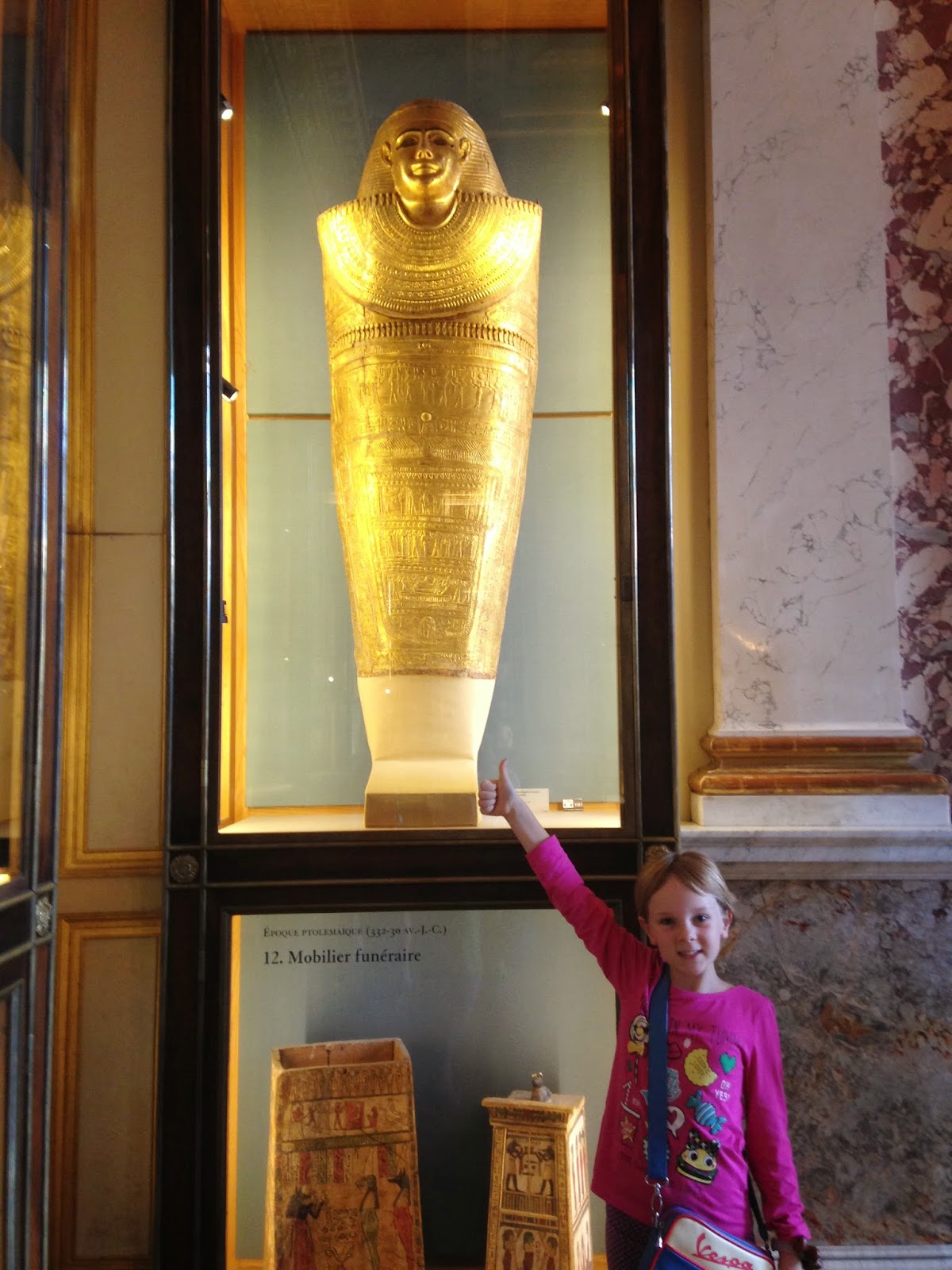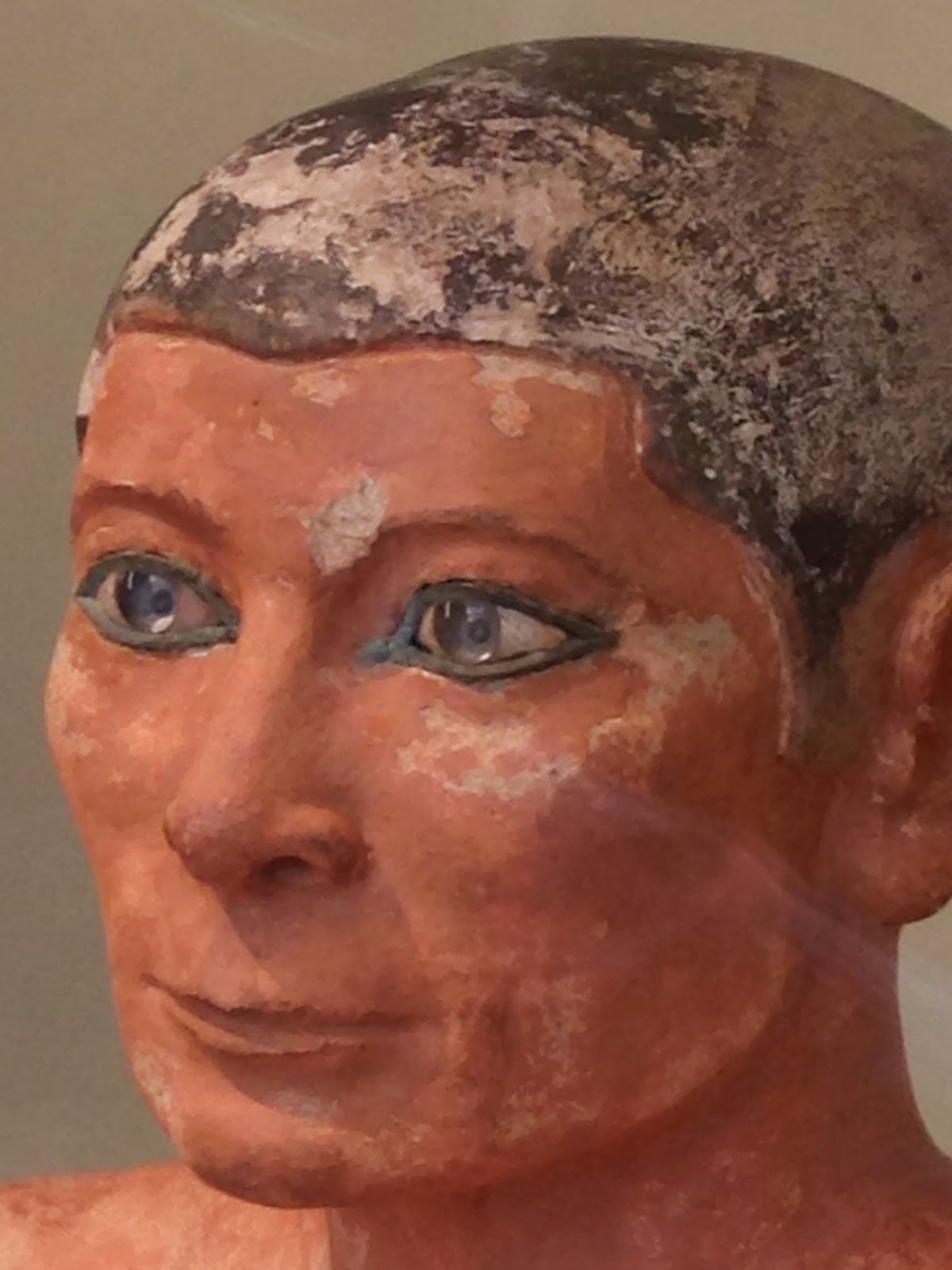Medieval History
 The city was in a giving mood today. Some days the bus pulls away, the sidewalk trips you, there's poop, one more document for the bank, a long list of grievances even though you know you're lucky. Other days, Paris just decides to smile upon you; smile into you. The bus pulls up as you do, the work of art you want to see is right near an air conditioning vent, the flowers seem especially bright, and you are presented with this sense that everything you're doing is just the best possible thing you could be doing right now. The kids and I finished out Egyptian art at the Louvre: hard to let go of the Old Kingdom (and we didn't entirely) but there was a Tutankhamun room (nothing splendid (would have to go to Cairo) housing a fascinating panel of princes from Libya, Nubia, and Syria offering up their homage to the boy pharaoh). The last of the last Egyptian rooms is devoted to the Ptolomeic pharaohs and Cleopatra VII. Very smartly, in these last rooms, you can start to see the Greek vase collection in the gallery parallel to the Egyptian one: by peeking through doors open between the two sets of galleries. The assignment for the day was to find an image that best exemplified the end of the galleries, of the Egyptian Empire. Eleanor chose this magnificent gold covering for a mummy because to her, the afterlife had always always always been important in Egyptian culture. "If they kept repeating the idea, it must be important." She favored the continuity argument. Oliver and Iris both chose works of art that bore the presence of Greek artists: rounder forms, more relaxed musculature, a hint of the Archaic smile. By the time you exit the Egyptian galleries, you're back in the Napoleonic Louvre: no more streamlined modernist galleries; instead, grandeur and echo. But I hadn't seen the Old Kingdom scribe - so back in we went (thank you, kids!)
The city was in a giving mood today. Some days the bus pulls away, the sidewalk trips you, there's poop, one more document for the bank, a long list of grievances even though you know you're lucky. Other days, Paris just decides to smile upon you; smile into you. The bus pulls up as you do, the work of art you want to see is right near an air conditioning vent, the flowers seem especially bright, and you are presented with this sense that everything you're doing is just the best possible thing you could be doing right now. The kids and I finished out Egyptian art at the Louvre: hard to let go of the Old Kingdom (and we didn't entirely) but there was a Tutankhamun room (nothing splendid (would have to go to Cairo) housing a fascinating panel of princes from Libya, Nubia, and Syria offering up their homage to the boy pharaoh). The last of the last Egyptian rooms is devoted to the Ptolomeic pharaohs and Cleopatra VII. Very smartly, in these last rooms, you can start to see the Greek vase collection in the gallery parallel to the Egyptian one: by peeking through doors open between the two sets of galleries. The assignment for the day was to find an image that best exemplified the end of the galleries, of the Egyptian Empire. Eleanor chose this magnificent gold covering for a mummy because to her, the afterlife had always always always been important in Egyptian culture. "If they kept repeating the idea, it must be important." She favored the continuity argument. Oliver and Iris both chose works of art that bore the presence of Greek artists: rounder forms, more relaxed musculature, a hint of the Archaic smile. By the time you exit the Egyptian galleries, you're back in the Napoleonic Louvre: no more streamlined modernist galleries; instead, grandeur and echo. But I hadn't seen the Old Kingdom scribe - so back in we went (thank you, kids!)
 This felt like a gift. I've studied and taught this figure for almost 17 years and I've always emphasized his vulnerability (the sagging muscles, the impermanent materials) and his lower status than the pharaohs. But in his presence, now in his own case (and not one among dozens of objects and buried in the back of a display case), I saw something else entirely: a piercing gaze that held me in its grasp and had us all asking questions. The eyes are "rock crystal" (rock crystal, mind you!) with little copper irises (for depth? for light?). It's just brilliant!!! He looked much more as though he were waiting and had all the patience in the universe to keep waiting. I see him as an infinitely more complex figure now. Yes, impermanence and desuetude, but those eyes! They really do seem to shine into eternity. Now, the usual art history questions follow: are these restorations? is the crystal original? has it merely been cleaned? I hope that this image can give you some sense of the beautiful "limpid pools"(yes!) of his eyes. I'm used to eyes being made of shell or painted on, but this, this was something else entirely. More present, more alive, more mischievous. I'll be teaching him entirely differently from how on!
This felt like a gift. I've studied and taught this figure for almost 17 years and I've always emphasized his vulnerability (the sagging muscles, the impermanent materials) and his lower status than the pharaohs. But in his presence, now in his own case (and not one among dozens of objects and buried in the back of a display case), I saw something else entirely: a piercing gaze that held me in its grasp and had us all asking questions. The eyes are "rock crystal" (rock crystal, mind you!) with little copper irises (for depth? for light?). It's just brilliant!!! He looked much more as though he were waiting and had all the patience in the universe to keep waiting. I see him as an infinitely more complex figure now. Yes, impermanence and desuetude, but those eyes! They really do seem to shine into eternity. Now, the usual art history questions follow: are these restorations? is the crystal original? has it merely been cleaned? I hope that this image can give you some sense of the beautiful "limpid pools"(yes!) of his eyes. I'm used to eyes being made of shell or painted on, but this, this was something else entirely. More present, more alive, more mischievous. I'll be teaching him entirely differently from how on!
 And then to meet a dear friend, and all of a sudden there's a café in the garden of the Palais Royal and the beer (why not?) is very good indeed and this friend of mine, we've been friends for 20 years now and talking with her is the same rush of excitement and shared enthusiasm as it ever was. The kids read their new books from W.H. Smith (yes, English bookshop - land of wonders) and we talked and talked. And then down some stairs, through a passage, and into Bistro Victoires where there's bustling and steak frites (see photo) and the waiter is super sympa and we all feasted and then shared the same crème brulée which made just the right noise when its ever-so-thin sheet of spun sugar was lightly tapped before we reveled properly. Because poetry and arithmetic often work hand in hand, today was my birthday and I am 45 years old and it was 20 years ago exactly that I had my birthday in Paris and Mac and I had just met and still it seems that all things are possible, that there are many days of great thanksgiving, and that the eyes of a scribe of 2,5000 years ago might shine brightly anew.
And then to meet a dear friend, and all of a sudden there's a café in the garden of the Palais Royal and the beer (why not?) is very good indeed and this friend of mine, we've been friends for 20 years now and talking with her is the same rush of excitement and shared enthusiasm as it ever was. The kids read their new books from W.H. Smith (yes, English bookshop - land of wonders) and we talked and talked. And then down some stairs, through a passage, and into Bistro Victoires where there's bustling and steak frites (see photo) and the waiter is super sympa and we all feasted and then shared the same crème brulée which made just the right noise when its ever-so-thin sheet of spun sugar was lightly tapped before we reveled properly. Because poetry and arithmetic often work hand in hand, today was my birthday and I am 45 years old and it was 20 years ago exactly that I had my birthday in Paris and Mac and I had just met and still it seems that all things are possible, that there are many days of great thanksgiving, and that the eyes of a scribe of 2,5000 years ago might shine brightly anew.
- Archaeologists Begin Restoring Ancient Boat Near Pyramids
Archaeologists on Monday began restoration on a 4,500-year-old wooden boat found next to the pyramids, one of Egypt's main tourist attractions. The boat is one of two that were buried next to the Pharaoh Khufu, spokesmen for a joint Egyptian-Japanese...
- Scribbled By A Community Of Nuns ? Medieval Coptic Graffiti Adorns Walls Of 3,200 Year-old Egyptian Temple
Who says nuns don?t have any fun? A new research project led by Professor Jennifer Westerfeld, of the University of Louisville, is taking a look at a unique set of graffiti scribbled onto the walls of a 3,200 year old Egyptian temple. The temple was built...
- Egyptian Museum Attacked, Artifacts Damaged
The heads of two mummies have been ripped off and several artifacts damaged by looters at the Egyptian Museum in Cairo, as unrest spreads throughout the country. The looters were captured by Egyptian soldiers before they were able to remove anything from...
- Fayum Friend
Lasting presence abounds in the descriptively dubbed East Mediterranean of the Roman Empire galleries. The Fayum portraits are their emblem and immediately place you in this end-of-an-era hybridity - it's the end of the Roman Empire as you know...
- Happy Birthday, Oliver
These ten days between Eleanor's birthday and Oliver's are always the craziest: turning grades in, saying good-bye to students, graduation, cleaning out the office, oh and there's a wedding anniversary in there somewhere. This summer,...
Medieval History
Scribe Eyes
- Archaeologists Begin Restoring Ancient Boat Near Pyramids
Archaeologists on Monday began restoration on a 4,500-year-old wooden boat found next to the pyramids, one of Egypt's main tourist attractions. The boat is one of two that were buried next to the Pharaoh Khufu, spokesmen for a joint Egyptian-Japanese...
- Scribbled By A Community Of Nuns ? Medieval Coptic Graffiti Adorns Walls Of 3,200 Year-old Egyptian Temple
Who says nuns don?t have any fun? A new research project led by Professor Jennifer Westerfeld, of the University of Louisville, is taking a look at a unique set of graffiti scribbled onto the walls of a 3,200 year old Egyptian temple. The temple was built...
- Egyptian Museum Attacked, Artifacts Damaged
The heads of two mummies have been ripped off and several artifacts damaged by looters at the Egyptian Museum in Cairo, as unrest spreads throughout the country. The looters were captured by Egyptian soldiers before they were able to remove anything from...
- Fayum Friend
Lasting presence abounds in the descriptively dubbed East Mediterranean of the Roman Empire galleries. The Fayum portraits are their emblem and immediately place you in this end-of-an-era hybridity - it's the end of the Roman Empire as you know...
- Happy Birthday, Oliver
These ten days between Eleanor's birthday and Oliver's are always the craziest: turning grades in, saying good-bye to students, graduation, cleaning out the office, oh and there's a wedding anniversary in there somewhere. This summer,...
